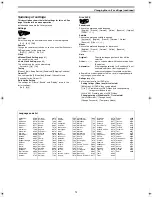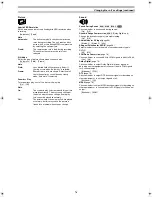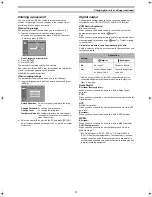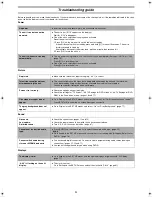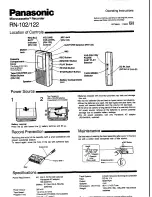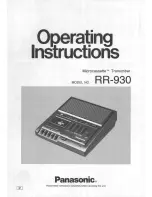
87
Maintenance
To clean this unit, wipe with a soft, dry cloth.
≥
Never use alcohol, paint thinner or benzine to clean this unit.
≥
Before using chemically treated cloth, read the instructions that
came with the cloth carefully.
Dust and dirt may adhere to the unit’s lenses over time, possibly
making it impossible to record or play discs.
Use the recommended
DVD-RAM/PD lens cleaner
(LF-K123LCA1)
every 1 to 4 months, depending on frequency of
use and the operating environment.
Read the lens cleaner’s instructions carefully before use.
The precision parts in this unit are readily affected by the
environment, especially temperature, humidity, and dust.
Observe the following points to ensure continued listening and
viewing pleasure.
Disc handling
Do not use irregularly shaped discs, such as heart-shaped.
(These can damage the unit.)
ª
How to hold a disc
Do not touch the recorded surface.
ª
If there is dirt or condensation on the disc
If the disc is dirty, wipe with a damp cloth and then wipe dry.
Moisture may condense on discs after they are brought inside from
the cold.
DVD-RAM and DVD-R
≥
Clean and dry only with the DVD-RAM/PD disc cleaner available
as an optional accessory, part number
LF-K200DCA1
. Do not
use cleaners or clothes for CDs to clean DVD-RAM and DVD-R.
≥
Never use cloths or cleaners for CDs, etc.
DVD-Video, Video CD and CD
Wipe it with a damp cloth and then wipe dry.
ª
Handling precautions
≥
Do not write on the label side with a ball-point pen or other writing
instrument.
≥
Do not use record cleaning sprays, benzine, thinner, static
electricity prevention liquids or any other solvent.
≥
Do not attach labels or stickers to discs. (Do not use discs with
exposed adhesive from tape or left over peeled-off stickers.)
≥
Do not use scratch-proof protectors or covers.
≥
Do not use discs printed with label printers available on the
market.
≥
Do not use discs that are badly warped or cracked.
ª
Do not place or store discs in the following places
≥
Locations exposed to direct sunlight
≥
Humid or dusty locations
≥
Locations directly exposed to a heat vent or heating appliance.
Bitstream
This is the compressed form of digital signals. A decoder decodes
these signals into 5.1 surround and multi-channel signals.
Channel (when referring to DVD)
Sound is divided into channels based on the sound’s role.
For example, 5.1 channel
≥
Front speakers — 1 left channel and 1 right channel
≥
Center speaker — 1 channel
≥
Surround speakers — 1 left channel and 1 right channel
≥
Subwoofer — 1 channel
k
0.1 (the ratio of bass to the total amount
of sound output)
Examples as shown in the on-screen menus
(1) 1: Subwoofer signal
(not displayed if there is no subwoofer signal)
(2) 0: No surround
1: Mono surround
2: Stereo surround (left/right)
(3) 1: Center
2: Front left
i
Front right
3: Front left
i
Front right
i
Center
Direct navigator
This is a list of programmes you have recorded. You can select
programmes from the list to view. The list also shows the date and
time of recording, the channel, and the titles of titled programmes.
The selected programme is played in the background, making
selection even simpler.
Dolby Digital
This is a method of coding digital signals developed by Dolby
Laboratories. Apart from stereo (2 channel) audio, these signals
can also be 5.1-channel audio. A large amount of audio
information can be recorded on one disc using this method.
Dolby Pro Logic
A surround system where a 4-channel audio track is recorded as 2
channels and then is restored to 4 channels for play. The surround
channel is monaural.
DTS Digital Surround
This surround system is used in many movie theaters around the
world. The separation between channels is good and the
compression ratio is low, so realistic sound effects are possible.
DTS soundtracks are produced with the assumption that all
channels will be used.
3/2 .1 ch
2
1
3
Glossary
Maintenance and Handling
E‑Text2.fm 87 ページ 2001年9月6日 木曜日 午後4時16分



